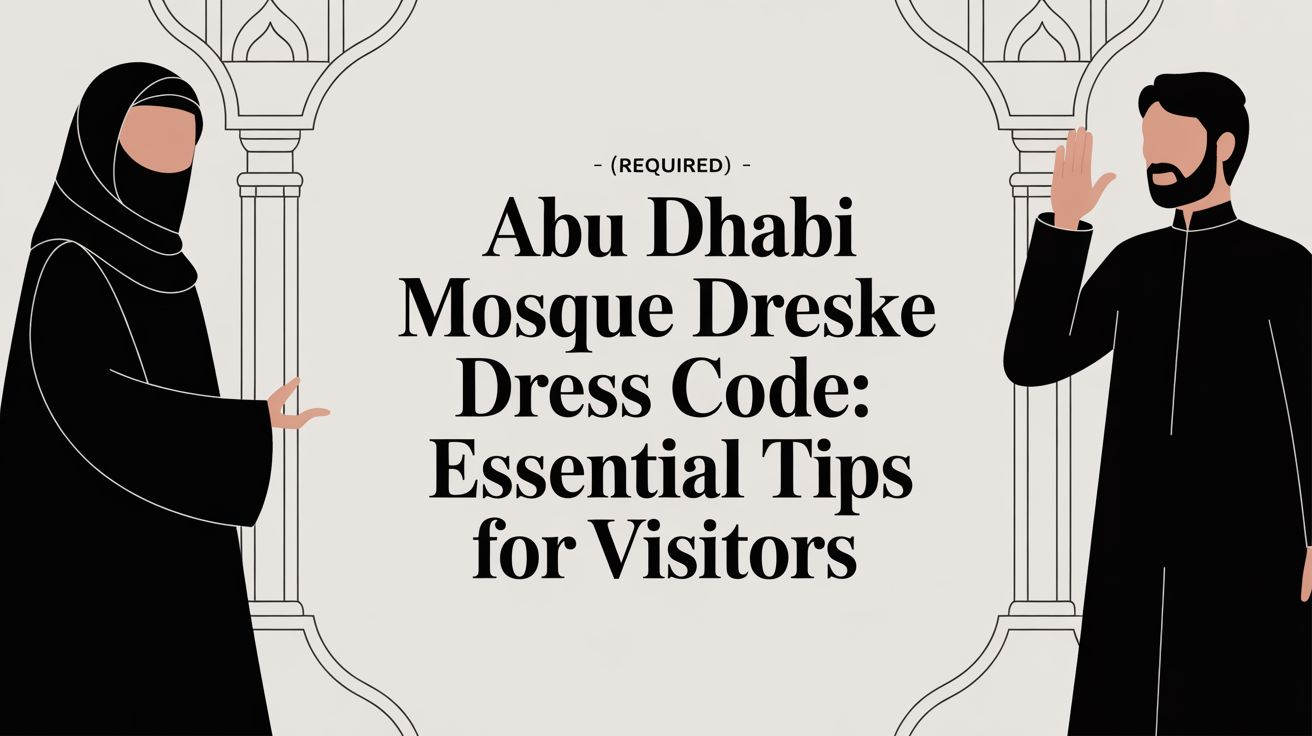When you're planning a trip to the Sheikh Zayed Grand Mosque, the first thing to get right is your outfit. The mosque requires all visitors to dress modestly and respectfully, which is key to ensuring a smooth and enjoyable visit. For men, this means long trousers and a shirt with sleeves. For women, the rules are a bit more specific: you'll need to be covered from your wrists to your ankles in loose-fitting, non-transparent clothing, and you must also wear a headscarf.
Understanding the Sheikh Zayed Mosque Dress Code
Figuring out what to wear to the magnificent Sheikh Zayed Grand Mosque is probably the most critical part of your planning. It's not just about following rules; it's a simple act of respect for a sacred place of worship. I like to think of it less as a restriction and more as a way to participate in the local culture, much like you would when visiting other major religious sites around the world.
The guiding principle here is modesty. The mosque maintains a strict dress code to preserve its sanctity, a policy that applies to the thousands of people who walk through its doors every day. Essentially, this means your clothes can't be see-through, tight, or revealing. For women, this includes covering your hair with a headscarf and ensuring your arms and legs are fully covered.
This infographic does a great job of breaking down the three foundational principles of the mosque's dress code.
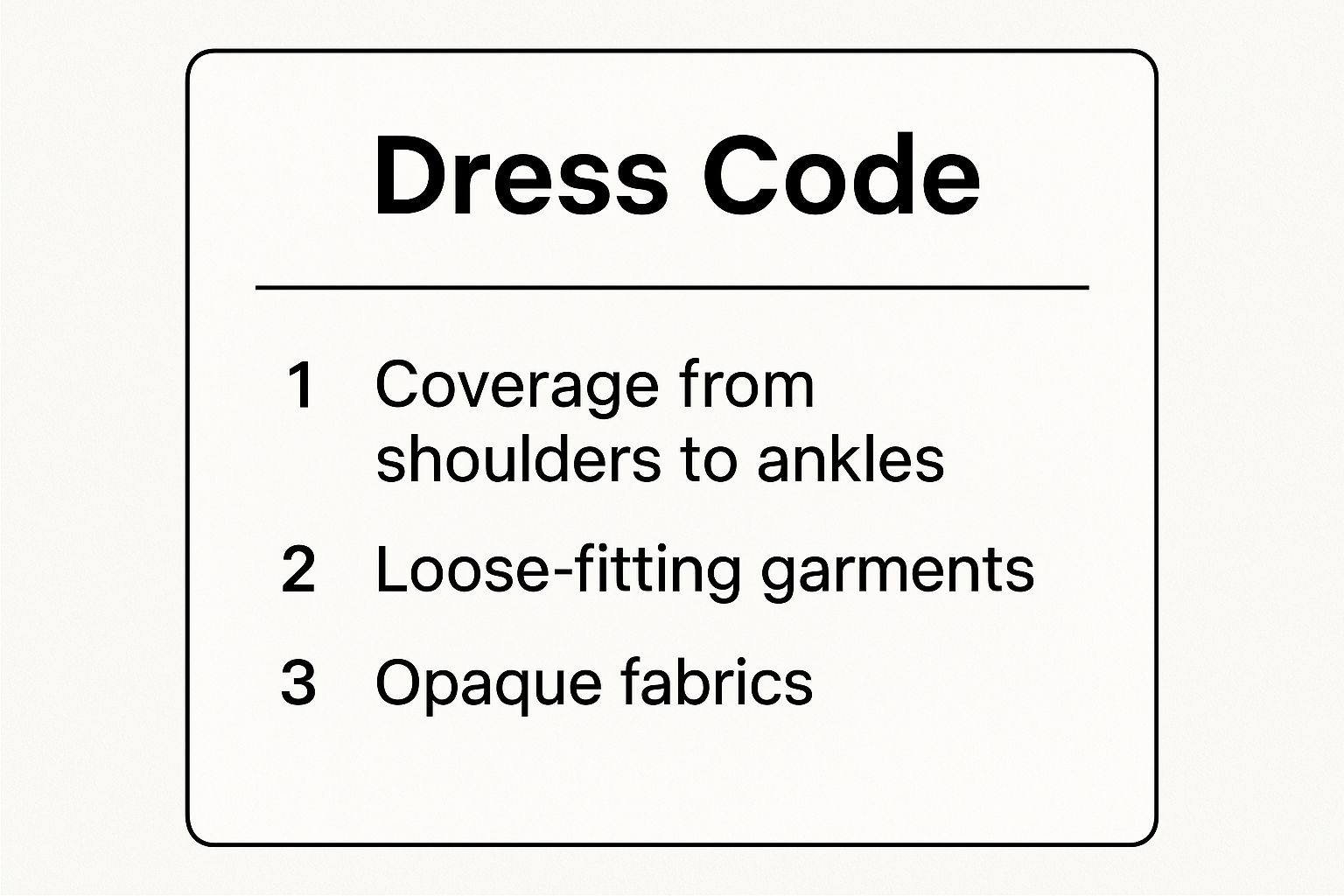
As you can see, the focus is squarely on three things: full coverage, a loose fit, and opaque fabrics. Getting these right ensures your outfit is perfectly appropriate.
Key Principles of Modest Attire
To make sure you get in without any issues, just keep these three core ideas in mind when choosing your outfit:
- Total Coverage: Your clothes need to cover you from your shoulders right down to your ankles. For men, long trousers are a must. For women, this means long sleeves and full-length pants, skirts, or dresses.
- Loose Fit: Steer clear of anything tight or form-fitting. Your clothing should be flowy and loose, hiding the shape of your body. This is exactly why things like skinny jeans or leggings aren't allowed, even though they technically cover your skin.
- Non-Transparent Fabric: Make sure your outfit is made from opaque material. Any sheer or see-through fabrics are a no-go, so it’s always a good idea to pick solid, thicker materials for your visit.
For a quick reference, this table breaks down the essentials for both men and women.
Mosque Dress Code at a Glance
| Visitor | Required Attire | Items to Avoid |
|---|---|---|
| Women | Long, loose-fitting trousers or skirts; long-sleeved shirts; headscarf (shayla). | Tight or transparent clothing, shorts, skirts above the ankle, sleeveless tops. |
| Men | Long trousers and shirts with sleeves (short or long sleeves are fine). | Shorts, tank tops, or sleeveless shirts. |
Getting the dress code right means you can put it out of your mind and focus completely on the stunning architecture. This principle of respectful attire is a good one to remember for other cultural landmarks, too. For more tips on visiting the capital's top spots, check out our guide on the Louvre Abu Dhabi.
Dress Code Guidelines for Women
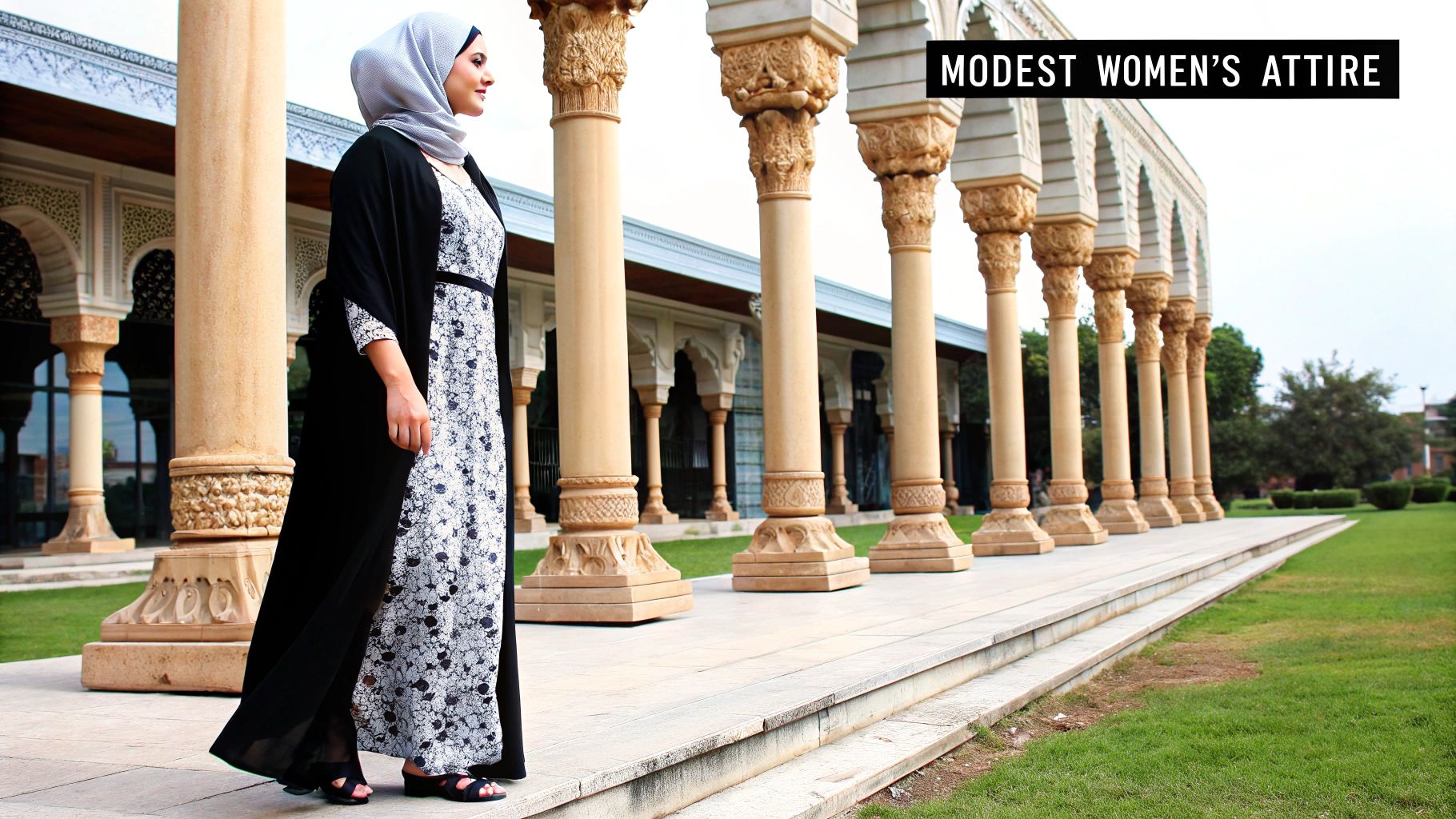
For women visiting the Sheikh Zayed Grand Mosque, the dress code all comes down to one key principle: modesty. Think of it less as a restriction and more as an opportunity to respectfully immerse yourself in the local culture. The guidelines are designed to ensure your clothing is loose, non-transparent, and covers you from your wrists down to your ankles.
The rules are pretty clear-cut, and following them makes for a much smoother, more enjoyable visit. The most important thing to remember is that "covered" also means the shape of your body should be concealed. That means items like skinny jeans, leggings, or form-fitting tops aren't appropriate, even if they technically cover your skin.
Choosing Your Outfit
You've got plenty of comfortable and even stylish options that fit the Abu Dhabi mosque dress code. A long, flowing maxi dress with full-length sleeves is often the easiest and most elegant solution. Another great combination is a pair of wide-leg trousers or a floor-length skirt paired with a loose, long-sleeved blouse.
Here’s a quick checklist for your outfit:
- Sleeves: Your sleeves need to go all the way to your wrists. Three-quarter-length sleeves won't cut it.
- Length: Your trousers or skirt must completely cover your ankles.
- Fit: Every piece of clothing should be loose and flowing, not tight.
- Fabric: Stick to opaque materials to ensure nothing is see-through.
The final, essential piece for women is the headscarf, known locally as a shayla. Your hair needs to be fully covered for the entire time you're inside. My advice? Bring a large, lightweight scarf that you can drape easily without it constantly slipping.
How to Wear a Headscarf
If you’ve never worn a headscarf, it might feel a little awkward at first, but it's simpler than it looks. A common way to wear it is to drape it over your head with one side longer than the other. Then, just wrap the longer end around your neck and tuck it over the opposite shoulder. A small pin can help keep it securely in place while you walk around.
The mosque’s approach is meant to be welcoming, not exclusionary. The real goal is to preserve the sanctity of this incredible place of worship while letting people from all over the world appreciate its beauty.
Don't worry if you arrive and realize your outfit isn't quite right. The mosque has a very practical system in place for the hundreds of thousands of non-Muslim tourists who visit each year. They provide complimentary abayas and headscarves for any female visitors whose clothing doesn't meet the requirements. This thoughtful gesture ensures everyone can experience the Sheikh Zayed Mosque respectfully without being turned away.
Dress Code Guidelines for Men
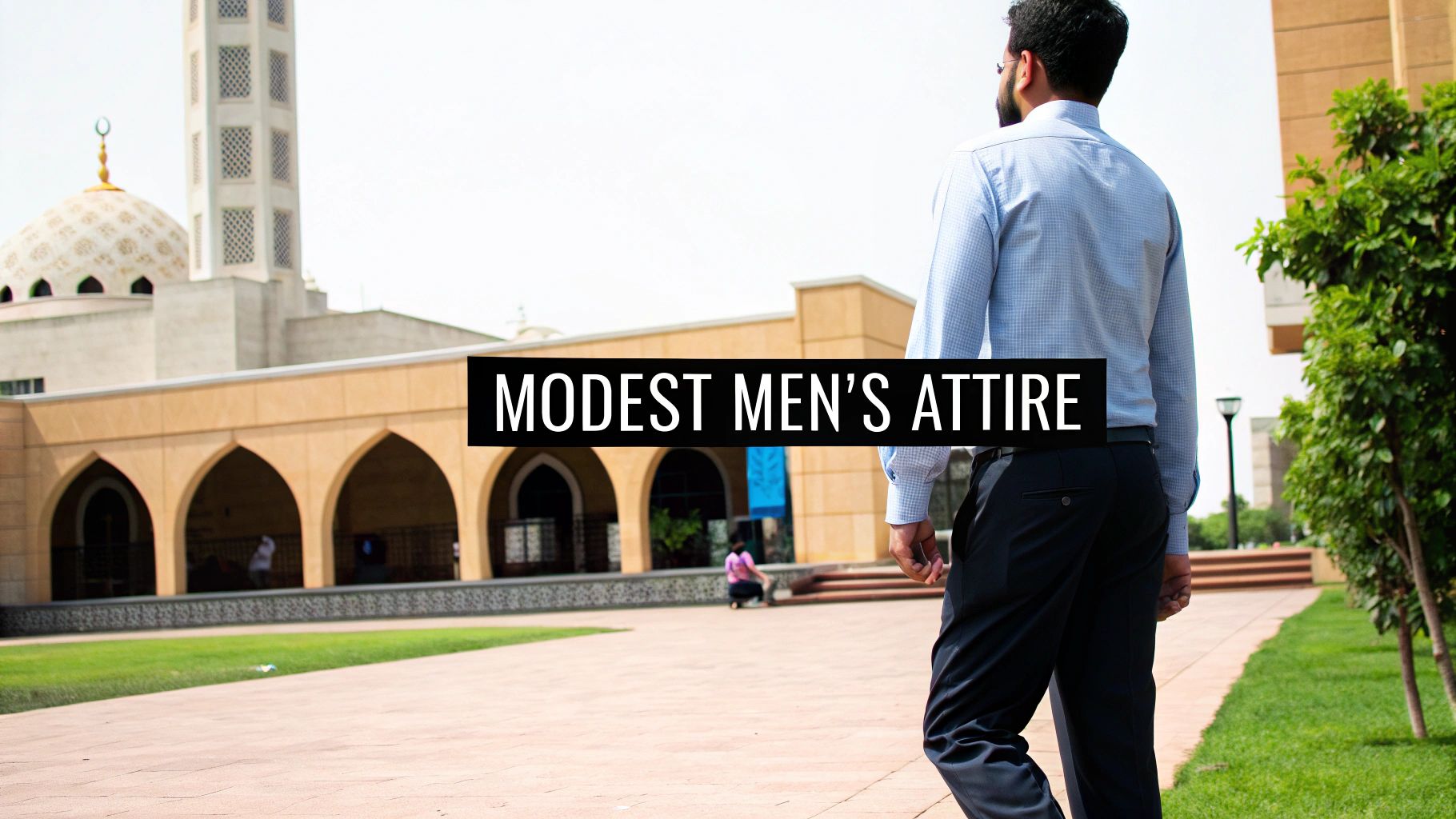
While a lot of attention goes to what women should wear when visiting the mosque, the guidelines for men are just as important. The rules are simple and designed to maintain the respectful atmosphere of this incredible place, so it’s easy to get it right.
The biggest rule to remember is about your lower body: you absolutely must wear long trousers that cover the ankles. This is a hard-and-fast rule. Shorts of any kind, even longer ones like capri pants that expose the calves, won't pass muster with the security staff at the entrance. They are quite diligent, so it’s best to just stick with lightweight trousers or a pair of chinos to stay cool.
What To Wear On Top
When it comes to your shirt, the main thing is to keep your shoulders covered. A simple t-shirt or a collared polo shirt is perfectly fine. Sleeveless tops, however, are a definite no-go.
- What works: Any standard short-sleeved t-shirt, polo shirt, or a long-sleeved button-down will be fine.
- What to avoid: Tank tops, muscle shirts, or any kind of vest that leaves your shoulders exposed will get you turned away.
The fit of your clothing is also a factor. Much like the rules for women, men should steer clear of anything too tight or form-fitting. This is all part of the mosque's broader emphasis on modesty. When in doubt, loose-fitting clothes are always the better choice.
Think of it this way: your clothing is a non-verbal gesture of respect for a place of active worship. By dressing appropriately, you help preserve the sacred and peaceful environment for everyone who visits.
A smart-casual look with loose trousers and a simple shirt ticks all the boxes perfectly. It shows you understand the cultural and religious significance of where you are.
And don’t panic if you show up and realize you've made a mistake. If your clothing doesn't meet the requirements, you won't be turned away completely. The staff will politely guide you to the shops in the underground mall where you can buy suitable attire, like a traditional kandura.
Respectful Conduct and Mosque Etiquette
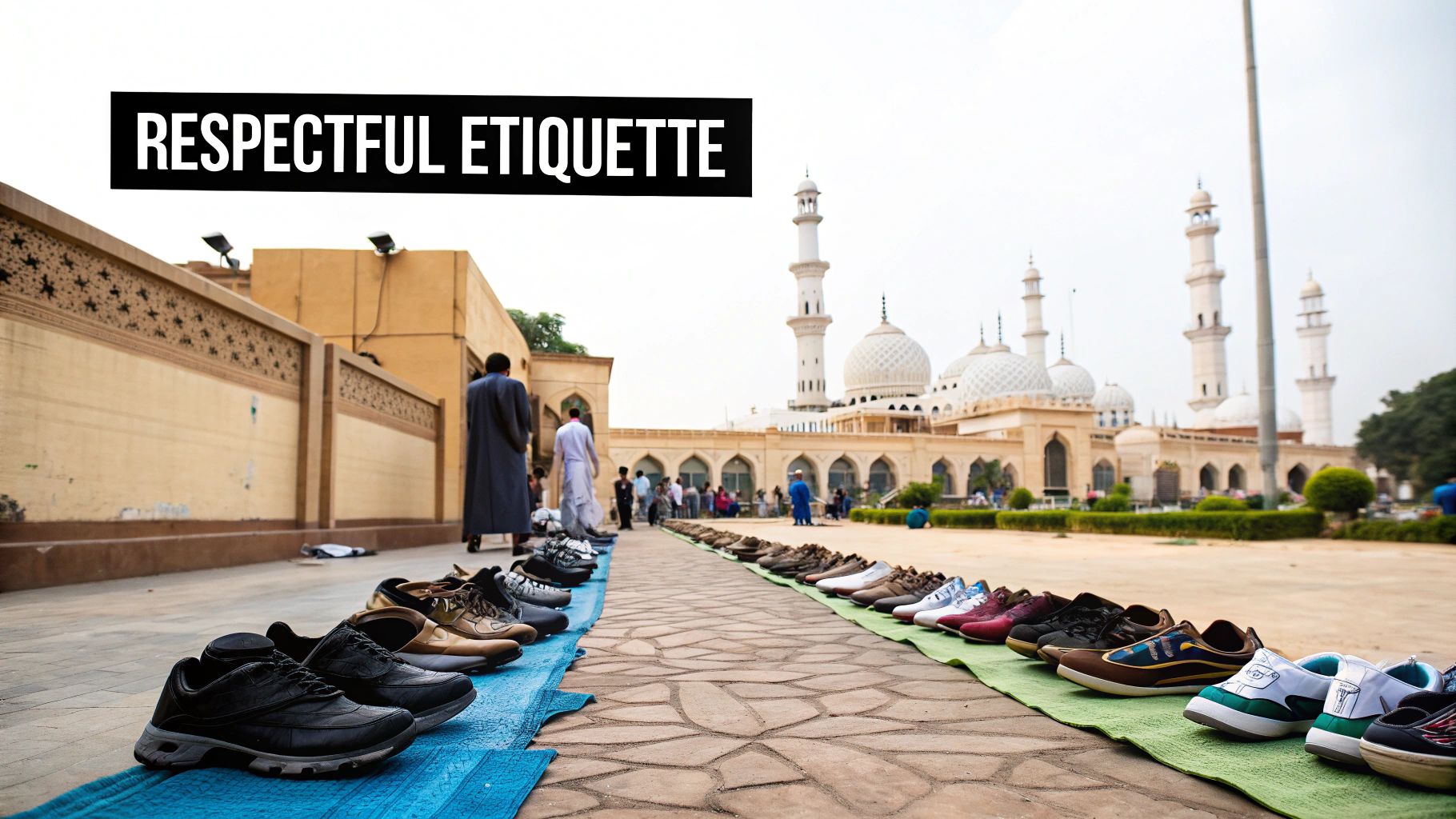
While dressing the part is crucial, how you carry yourself inside the mosque grounds is just as important for showing respect. This isn't just a tourist attraction; it's an active place of worship. The best way to think about it is like being an invited guest in a deeply sacred home—your actions should be quiet, mindful, and considerate.
One of the first things you'll do is remove your shoes before entering the main prayer hall. This isn't just a custom; it protects the stunning hand-knotted carpet where worshippers place their foreheads on the ground to pray.
Maintaining a Serene Atmosphere
The mosque's incredible sense of peace is something everyone contributes to. To play your part in preserving this tranquil environment, keep a few key things in mind:
- Keep Your Voice Low: Speak in quiet, hushed tones. Any loud talking or shouting really stands out and is considered quite disruptive.
- No Public Displays of Affection: This is a firm rule. Holding hands, hugging, and kissing are not appropriate in this conservative religious setting.
- Mind Your Photo Poses: You can take plenty of photos, but be mindful of your poses. Staff will intervene if you're making theatrical gestures, throwing up peace signs, or treating the visit like a personal photoshoot. The idea is to capture the beauty of the architecture, not to create a spectacle.
Understanding these cultural nuances is just as vital as following the dress code. Your behaviour communicates a deep respect for the faith and heritage the mosque represents, ensuring a positive experience for both you and the worshippers. This level of cultural awareness is key when exploring other historical sites you must see in the UAE.
Don't be surprised to see staff actively enforcing these rules. They conduct daily checks on both dress and behavior, and they take it very seriously. After a few high-profile incidents where visitors ignored the rules, the mosque has become even more diligent about upholding its standards for everyone's benefit.
A Few Practical Tips for a Smooth Visit
A little bit of planning can make all the difference between a good visit and a truly incredible one. When it comes to the mosque, timing is key. Try to get there either early in the morning as soon as it opens or later in the afternoon. This way, you’ll dodge the worst of the midday heat and the biggest tour bus crowds.
The entire visitor experience is surprisingly modern and streamlined. You'll start by entering through a beautiful glass dome and taking an escalator down into an underground mall. It's a clever way to manage the flow of people and give you access to amenities before you even set foot in the mosque proper.
Getting Inside
Once you're in the mall, you'll go through a security check where they'll also look at your clothing to ensure it meets the mosque's dress code. If what you're wearing isn't quite right, they'll point you toward shops in the mall where you can buy suitable clothes. It's worth noting that they no longer offer complimentary robes to borrow on-site, so it's best to arrive prepared.
After clearing security, a travelator takes you through a long underground tunnel. The walk itself is about 5-10 minutes, and it builds the anticipation perfectly before you emerge into the stunning main courtyard. For maximum comfort, make sure you have a few things with you:
- Sunglasses: An absolute must. The brilliant white marble is dazzling, and sunglasses will save your eyes from the intense glare.
- Comfortable shoes: You'll be doing a lot of walking, so this is not the time for brand-new or uncomfortable footwear.
- A reusable water bottle: Staying hydrated is important, especially if you're visiting during the warmer months.
The biggest mistake I see visitors make is not factoring in the time it takes to get from the entrance dome to the mosque itself. Give yourself that extra buffer for the mall and tunnel walk so you don't feel rushed.
Pacing yourself is crucial, particularly if you have kids in tow. If you're looking for more ideas to keep everyone happy, our guide on family activities in Abu Dhabi has some great suggestions to round out your trip. A little preparation ensures your visit is memorable for all the right reasons.
A Few Common Questions About the Mosque Dress Code
Even when you think you have the dress code figured out, a few specific questions always seem to pop up, especially for first-timers. Let's clear up some of the most common ones so you can finalize your plans without a second thought.
A lot of visitors ask if they can bring their own abaya or headscarf. The answer is a definite yes. If you have your own modest clothing that meets the mosque's standards—meaning it isn't see-through, it's loose, and it covers you properly—you're more than welcome to wear it. In fact, it's often the most comfortable option.
What about the kids? Thankfully, the rules are much more relaxed for young children. Still, it's always a good idea to dress them in respectful, modest clothing. Once they hit their pre-teen and teenage years, it’s best for them to follow the adult guidelines to ensure a smooth entry.
What Happens If I Show Up in the Wrong Outfit?
It’s a traveler’s worst nightmare: you arrive at a world-famous landmark, full of excitement, only to be told you can’t come in. If you get to the mosque and your clothing isn't quite right, don't panic. They won’t just turn you away.
Mosque staff will simply and politely point you toward the shops in the underground mall near the entrance. There, you can easily buy something appropriate to wear.
Think of it less as a penalty and more as a helpful solution. The mosque's priority is to let everyone experience its incredible beauty while maintaining a respectful atmosphere, and this system makes it easy to do just that.
You’ll find everything from simple, budget-friendly abayas to more elaborate ones that make for a wonderful souvenir. A small wardrobe oversight won't keep you from seeing one of Abu Dhabi's most spectacular sights.
A Few Other Key Questions
To make sure all your bases are covered, here are a few more quick-fire answers to questions we hear all the time:
- Can men wear a kandura? Absolutely. The traditional Emirati tunic is considered respectful and is perfectly fine to wear.
- Are there changing rooms? Yes, you'll find changing rooms in the underground mall, so you can switch into your mosque-appropriate outfit right before you go through security.
- Do I have to pay to get in? Nope. Entry to the Sheikh Zayed Grand Mosque is completely free. You just need to register for a pass, which you can do online beforehand or by using the QR codes when you arrive.
Of course, packing the right clothes is just one part of planning an amazing trip to the UAE. If you're looking for unforgettable tours and experiences in Abu Dhabi, My Global Trips can help you book your next adventure. Check out the best deals and start making memories at https://www.myglobaltrips.com.

